Danaus plexippus
(Linneaus, 1758) (Papilio)
Danaus plexippus, male, Florida, courtesy of Leroy Simon.
Superfamily: Papilionoidea | Website designed and maintained |
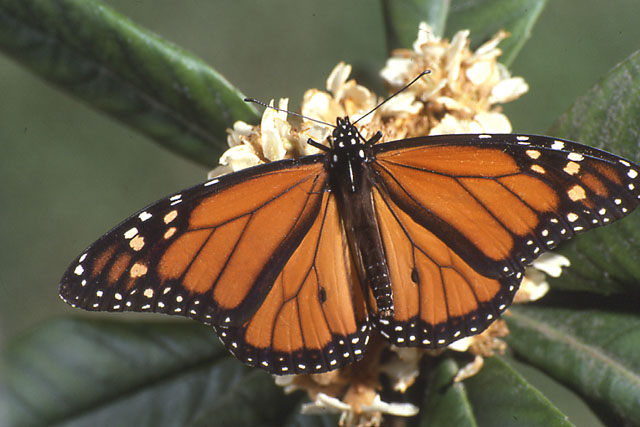
Danaus plexippus, male, Florida, courtesy of Leroy Simon.
Superfamily: Papilionoidea | Website designed and maintained |
I do see them occasionally in mid to late summer here on Prince Edward Island in eastern Canada, but I do not believe that they produce a brood here.
This species flies throughout much of South America and is also present in Australia, Hawaii, and other Pacific Islands.
Black vein lines are thin in males and much thicker in females. Males also have a black patch of scent scales on each hindwing.
The ventral surfaces are similar but the orange colouration is much paler than on the upper surfaces.
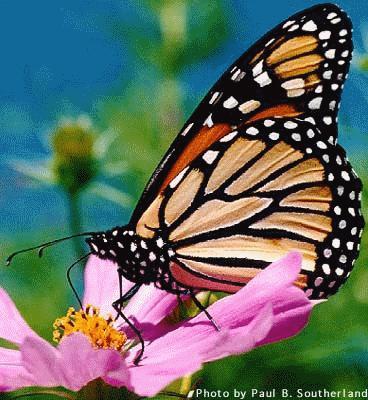 |
"Somewhere.Over.the.Rainbow"copyright C. Odenkirk MIDI CITY ON.OFF |
More often, however, my prize was able to see or sense my encroaching
hand and lift off, leaving my mouth open and my fingers empty.
It wasn't until much later in my life that I learned of the fascinating
migratory habit of this insect.
Wherever you can find milkweed, you can find monarchs. In New Jersey, where I grew
up, Common Milkweed (Asclepias syriaca) was abundant in open fields. For those who
wish to cultivate this "weed", there are many seed sources on the internet. Photo courtesy of Monarch Watch |
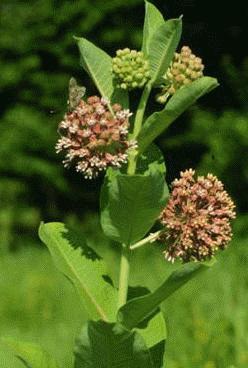 |
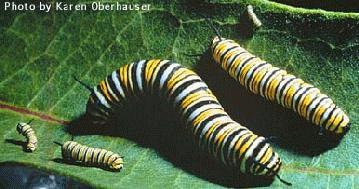
| Eggs usually emerge in a few days and tiny larvae often eat the soft leaf tissue on the under surface before moving to leaf edge. Progression through five very similarly coloured instars is rapid.Larvae usually feed from the underside of the leaf and sometimes also eat flower stems. Photo courtesy of Monarch Watch |
The jewel like pupa or chrysalis is a striking jade green with black and yellow dots.Development is rapid and wing colours and outlines become clearly visible prior to emergence (eclosion). The pupal stage only lasts about nine days, and butterflies must "hang" to inflate their wings. Images courtesy of Monarch Watch | 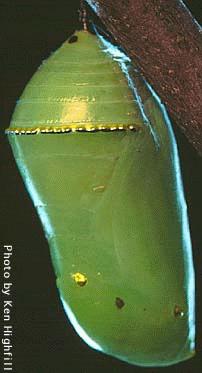 | 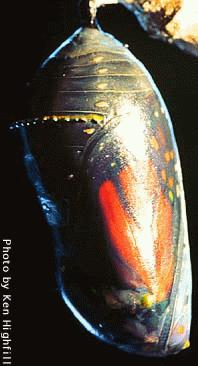 |
My mother, at age 75, still rears monarchs (usually only a half dozen or so at a time) as single larvae in 750-1000ml peanut butter jars. Larger jars or rearing containers are preferred, and a completely (almost) natural setting is most desirable. A small enclosure over a live milkweed plant works well. The enclosure material can be anything that allows for air circulation and light penetration and protects the larvae from other insect predators.
As a younster I had the pleasure of walking inside a very large enclosure, approximately 30 feet by 30 feet square and eight feet high, on the property of Mel Osbourne. Dr. Osbourne had many large milkweed plants and other adult food sources growing in the cage. Butterflies were flying about, mating, feeding, and laying eggs. Larvae could easily be found at various stages of development.
Dr. Osbourne needed a good supply of larvae, pupae, and adults for the life histories he was preparing.
Adults feed on nectar from all milkweed species. Prior to the opening of the milkweed flowers, adults are often seen on dogbane, lilac, red clover, lantana, and thistles. In the fall, adults visit composites including goldenrods, blazing stars, ironweed, and tickseed sunflower.
I seem to remember them at joe pie weed and butterfly bush.

Danaus plexippus, female, Florida, courtesy of Leroy Simon.
Pale green eggs are deposited singly on the undersides of milkweed leaves. Incubation is short, only a few days, and larval development is very rapid. Larvae pass through five instars before hanging from a silk mooring and forming their chrysalids. All five instars have similar colouration.

Danaus plexippus, larva, Florida, courtesy of Leroy Simon.

Danaus plexippus, pupa, Florida, courtesy of Leroy Simon.
Otherwise, if you wish to see monarchs in your garden, cultivate some milkweed.
Quart sized jars, lids on tight with no airholes (necessary to conserve moisture in foliage), make nice little rearing containers. Larvae will probably hang from cardboard liner in lid to form the chrysalids.
Emergent butterflies are able to hang from the empty pupal shell while they inflate their wings by pumping body fluid into the wing veins.
The inflation process usually only takes about fifteen minutes and then another hour or so is needed for wings to dry or stiffen in preparation for flight.
The milkweed plant contains toxins that caterpillars/butterflies are able to assimilate in such a way as to make them distasteful to birds. Many people write that viceroys mimic the monarchs' colouration and patterning as a protection against avian predators.
Use your browser "back" button to return to previous page.
Visit other websites maintained by Bill Oehlke:
I offer two membership sites that far exceed the
coverage offered
on the sites listed above:
THE WORLD'S LARGEST SATURNIIDAE SITE and
CATERPILLARS TOO! North American (Canada/US) Butterfly website
|
 |